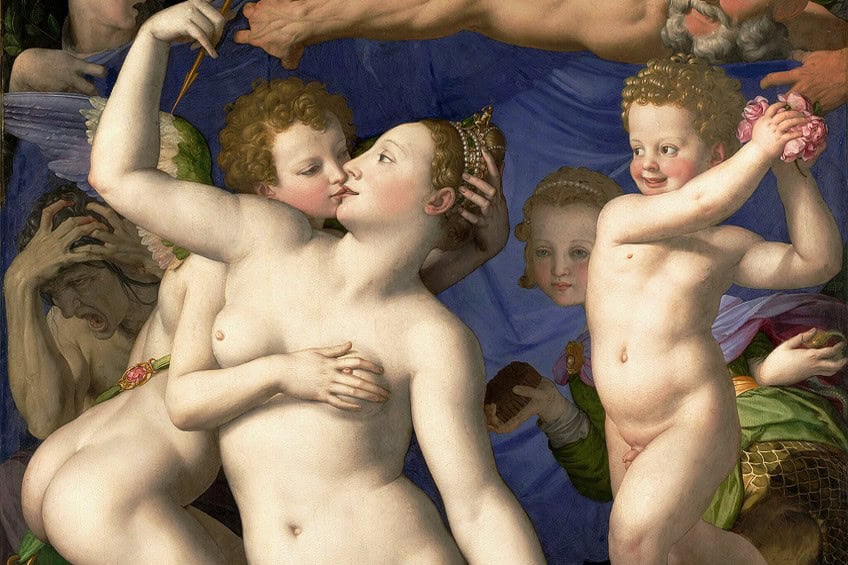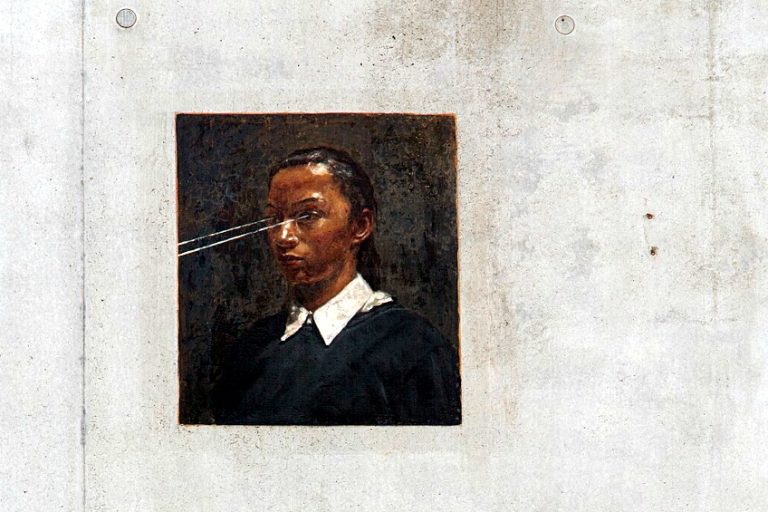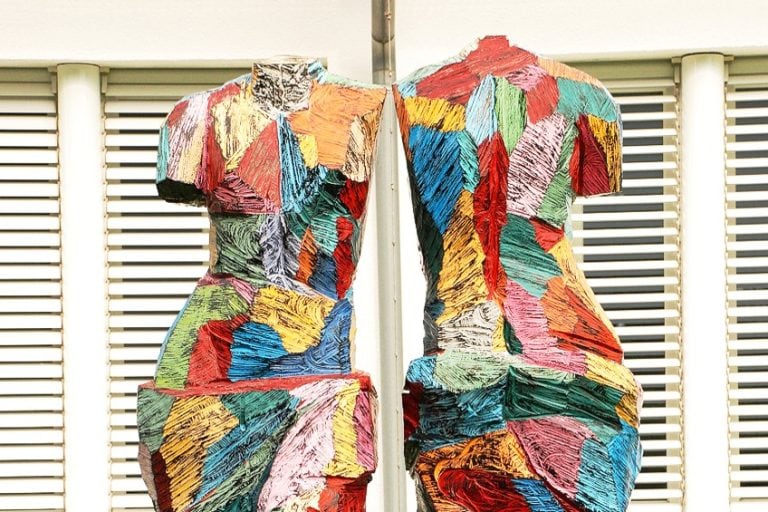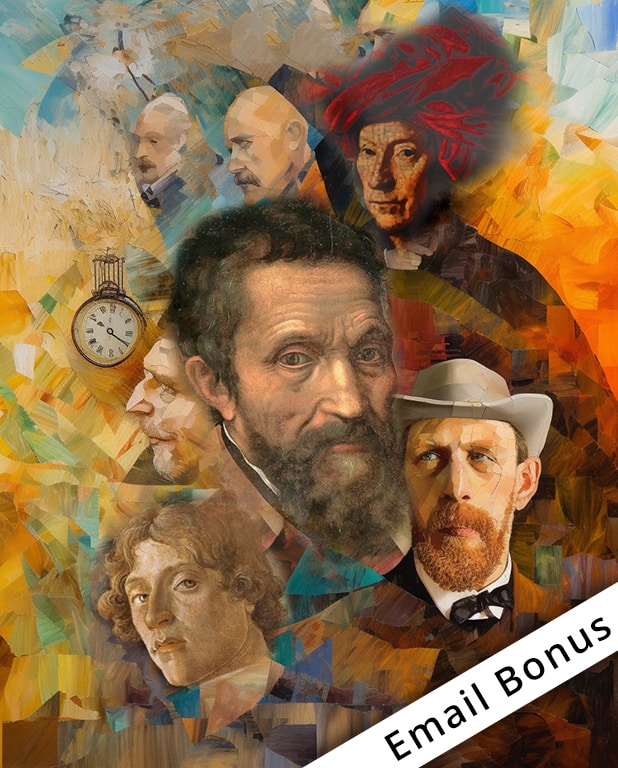Bronzino – The Master of Mannerist Portraiture
Agnolo di Cosimo, known as Bronzino, was a leading Italian Mannerist painter, renowned for his refined portraiture and elegant style. Active primarily in Florence, Bronzino worked as the court painter for the powerful Medici family, capturing their likenesses with remarkable precision and a cool, polished aesthetic. His work is characterized by its smooth surfaces, intricate details, and often aloof yet idealized figures, reflecting the intellectual and sophisticated tastes of the Medici court. Bronzino’s paintings, such as Portrait of Eleonora di Toledo with Her Son and Venus, Cupid, Folly, and Time, are celebrated for their technical mastery and complex symbolism, marking him as a pivotal figure in the Mannerist movement.
Key Takeaways
- Bronzino was a master of Mannerism and court painter for Cosimo de’ Medici.
- Known for his elegant portraits, his work remains a key representation of the Mannerist style.
- Bronzino’s influence endures in the art world for its innovation and elegance.
Early Life and Training
| Birth | November 17, 1503 |
| Death | November 23, 1572 |
| Place of Birth | Florence, Republic of Florence |
| Genre of Work | Mannerism painting |
In the heart of Renaissance Florence, a masterful artist known to the world simply as Bronzino made his mark. Born Agnolo di Cosimo in 1503, Bronzino flourished during a time when the Mannerist style was taking shape, characterized by its artificial aesthetic that pushed boundaries beyond the naturalism of the High Renaissance.
Renowned for his polished and elegant portraits, Bronzino became a leading figure of Mannerism, leaving behind a legacy that continues to captivate art enthusiasts.

Bronzino’s rise to prominence is marked by his role as a court painter for Cosimo de’ Medici and his family, a position that allowed him to refine his signature style. His works reveal a world of sophistication and grandeur, often capturing the elite of his time with remarkable precision and grace. Through masterpieces like An Allegory with Venus and Cupid and Portrait of a Young Man, Bronzino’s art embodies the ability of Mannerism to blend complexity with elegance.
Apprenticeship With Pontormo
Bronzino began his artistic journey under the tutelage of Jacopo da Pontormo, a key figure in Florentine art. Pontormo’s workshop became a place where Bronzino honed his skills and absorbed critical techniques. Known for his distinct style, Pontormo introduced Bronzino to new approaches in color and composition.
This apprenticeship was crucial, providing Bronzino with a strong foundation in painting.
Under Pontormo’s guidance, Bronzino learned to appreciate the complex expressions and figures characteristic of the Mannerist style. His dedication to detail and mastering of portraiture had its roots in these early years. Pontormo’s influence persisted in Bronzino’s work, evident through his use of striking imagery and dynamic poses.
Influence of Michelangelo and Raphael
As Bronzino’s career progressed, the artistic legacies of Michelangelo and Raphael played substantial roles in shaping his style. These artists, renowned for their contributions to the High Renaissance, inspired many aspects of Bronzino’s visual art. Michelangelo’s mastery of anatomy and dramatic expression left a lasting impact on Bronzino.

Similarly, Raphael’s delicate balance and compositional harmony are reflected in Bronzino’s later work. While Michelangelo’s robust figures influenced his depiction of human anatomy, Raphael’s stylistic elegance supplemented Bronzino’s artistic vocabulary. This blend of influences helped Bronzino establish a refined and polished aesthetic that defined his legacy in Florentine art.
Work as a Court Painter
Agnolo Bronzino’s role as a court painter reflects his close ties with the Medici family, particularly Cosimo I de’ Medici, and showcases his contributions to the evolution of Florentine court portraiture. His work includes significant commissions that highlight his mastery in capturing the essence of his subjects.
Association With Cosimo I de’ Medici
Bronzino became the court painter to Cosimo I de’ Medici, the Duke of Florence, around 1540. This position significantly elevated his status in the Florentine art scene. His relationship with Cosimo I was not merely professional; Bronzino was deeply intertwined with the court’s political and cultural ambitions.
Cosimo appreciated Bronzino’s ability to convey power and poise in his portraits, which in turn enhanced the Medici’s image across Europe.
His role extended beyond traditional portraiture. Bronzino played a part in visualizing the grandeur and legitimacy of the Medici rule. His work included not only court paintings but also possible involvement in frescoes that adorned public and private spaces of power such as Palazzo Vecchio. He was at the heart of the Medici’s cultural propaganda.
Major Commissions and Florentine Influence
Bronzino’s major commissions for the Medici family included portraits that were integral to the identity of Cosimo and his wife, Eleonora of Toledo. His renowned works, such as Portrait of Eleonora of Toledo and Her Son, exemplified stylistic elegance and richly detailed backgrounds, elements that became hallmarks of Medicean portraiture.

Florentine influences are evident in Bronzino’s adaptation of Mannerism, characterized by elongated forms and composed figures. His paintings often contained symbolic elements that resonated with the Medici’s authority. By integrating artistic techniques from his mentor, Pontormo, Bronzino preserved and expanded Florence’s rich artistic traditions.
Evolution of Court Portraiture
Bronzino’s tenure as a court painter marked a transformative period in court portraiture, where the stylistic shift aligned with the Dukes’ aspirations. His portraits combined pictorial precision with emotional restraint, adhering to the Mannerist ideals prevalent in Florence. The focus on minute details and textural richness depicted the sitter’s social status.
His approach set a precedent for European courts, influencing the portrayal of nobility beyond Italy.
The refined aura and silent power in his works laid the groundwork for future portraitists, establishing a template for courtly elegance. This evolution was pivotal, shaping the artistic landscape of Renaissance Florence and enhancing cultural diplomacy.
Masterpieces and Artistic Style
Bronzino’s work exemplifies Mannerism through its elegant compositions and refined technique. His masterpieces often highlight themes of courtly idealism and religious depth, showcasing his ability to blend style with profound narratives.
Portrait of a Young Man and Other Renowned Works
Bronzino’s Portrait of a Young Man showcases his skill in capturing the intricate elegance typical of Mannerist portraiture. This masterpiece features a young man posed confidently, reflecting both intellectual sophistication and courtly charm. Its meticulous attention to detail, such as the texture of fabrics and the subtle play of light, exemplifies the craftsmanship that defined Bronzino’s legendary status.

Other significant works include the Allegory of Venus, Cupid, Folly, and Time, illustrating themes of lust and folly with an unsettling yet vibrant energy. This painting captures the complexity of human emotion, enhanced by Bronzino’s bold use of color and intricate composition.
Unique Characteristics of Mannerist Style
Bronzino’s artistic style embodies the unique attributes of Mannerism, characterized by its emphasis on artificiality and elegance. Unlike the harmonious compositions of the Renaissance, Mannerism favors elongated forms and exaggerated poses to create a sense of movement and tension.
Bronzino cleverly employed these features to create visually captivating scenes while maintaining a cool emotional restraint.
His use of bright and often unusual coloring adds a layer of sophistication to his works. Through controlled brushwork and complex spatial arrangements, his paintings maintain a refined aesthetic that sometimes conveys a sense of aloofness and formality.
Contributions to Religious and Mythological Art
In religious and mythological art, Bronzino’s work is noted for its depth and rich symbolism. His Noli Me Tangere and Pietà pieces reveal powerfully emotive storytelling through precise detail and allegorical imagery. These artworks illustrate both his technical mastery and his ability to infuse narrative into grand, ecclesiastically significant scenes.
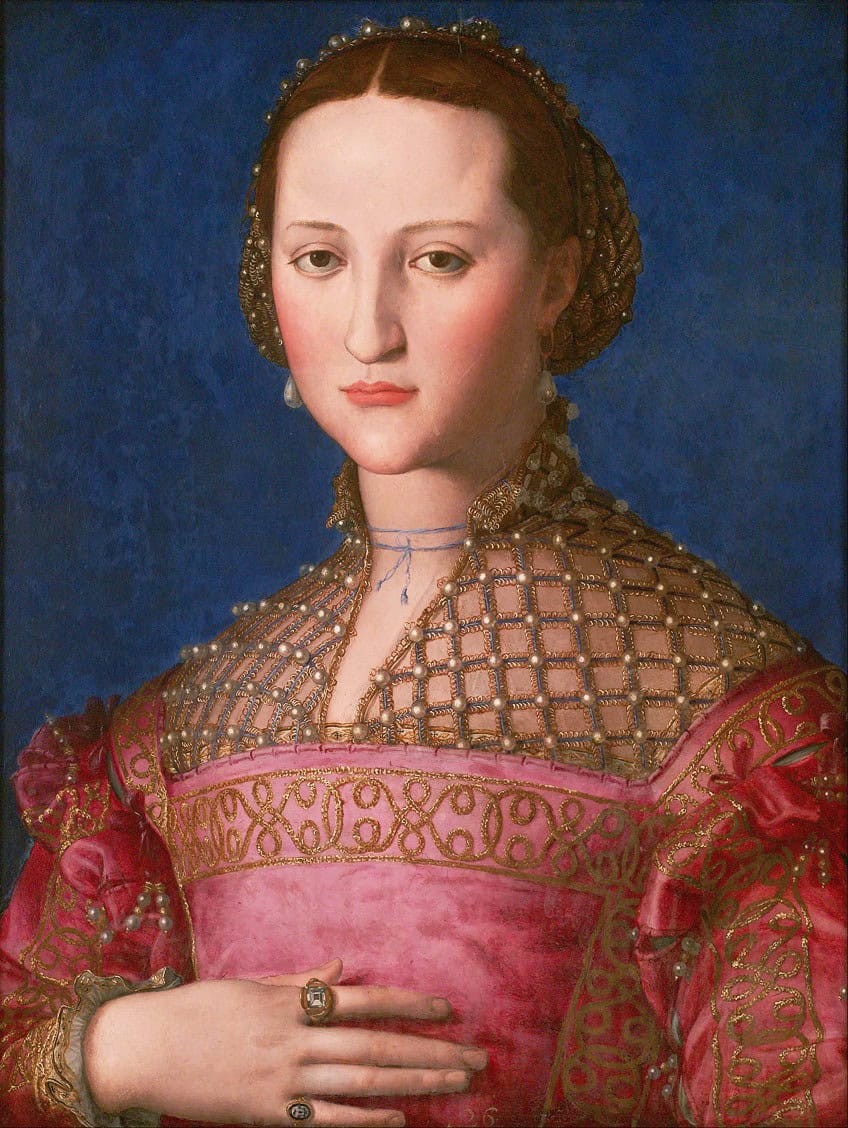
His contributions also include a notable fresco cycle and numerous paintings in oil on wood. These works often highlighted moral and theological themes using the sophisticated visual language distinctive to the Mannerist period. Bronzino’s legacy in religious art maintains a significant place in art history for its evocative blend of spirituality and elegance.
Legacy and Influence
Bronzino’s artwork significantly impacted both Italian and European art through his polished portraits and tapestries. His works are still celebrated in major institutions such as the Uffizi Gallery and the National Gallery.
Impact on Italian and European Art
Agnolo Bronzino’s influence is evident in the way he shaped portraiture and religious art during the Italian Renaissance. His elegant portrayal of subjects became a model for courtly painting, influencing artists like Giorgio Vasari.
Bronzino’s style was characterized by precise detail and striking color, setting a standard that resonated beyond Italy and across Europe.
At the Medici court, Bronzino painted King Francis I of France among others, enhancing cultural exchanges between Italy and Europe. His emphasis on intellectual themes and aesthetic sophistication exemplifies the Italian Mannerist movement. His works continue to guide modern interpretations of Mannerist aesthetic principles.
Works Held by Prominent Institutions
Bronzino’s works are widely preserved in renowned art institutions worldwide. The Uffizi Gallery in Florence houses many of his striking portraits that showcase his revolutionary take on nobility and elegance. The National Gallery in London features his famed painting, Venus, Cupid, Folly, and Time, highlighting his mastery in mythological themes.
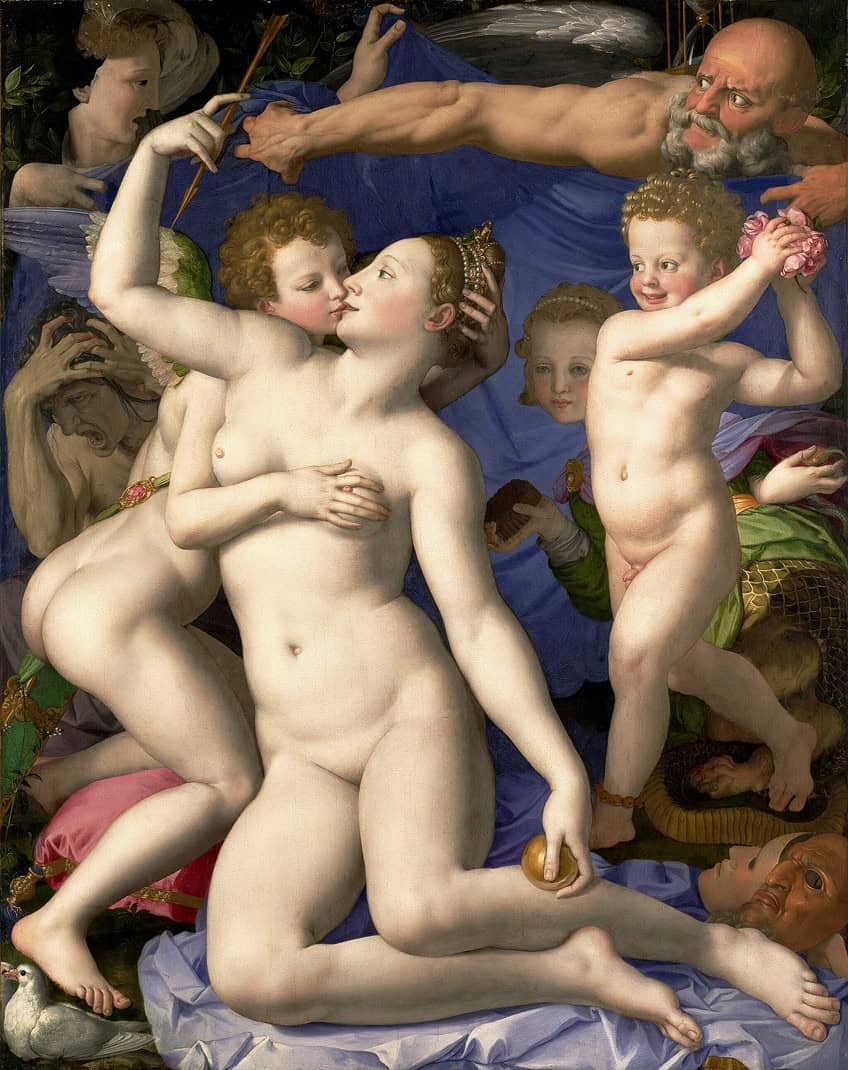
The Metropolitan Museum of Art in New York also holds important pieces reflecting his unique touch. Tapestries attributed to Bronzino, designed for the Medici, can be found in various collections, underlining his influence in diverse art forms. These institutions play a crucial role in maintaining and displaying Bronzino’s artistic legacy for contemporary audiences.
Bronzino’s mastery of form, color, and composition solidified his status as one of the foremost painters of the Mannerist era. His ability to blend idealization with subtle realism, particularly in portraiture, not only defined the aesthetic of his time but also left a lasting influence on future generations of artists. Bronzino’s work, with its meticulous attention to detail and intellectual underpinnings, remains a testament to the sophistication and grandeur of the Florentine court, ensuring his legacy as a key figure in the evolution of Renaissance art into Mannerism.
Frequently Asked Questions
What Is the Significance of Bronzino’s Mannerist Style in His Paintings?
Bronzino’s Mannerist style is characterized by elegance, elongated forms, and refined figures. This approach diverges from the naturalism of the High Renaissance, focusing on complex compositions and sophisticated color palettes. His works often feature intricate poses and subtle details, which contribute to the sense of grace and poise that define his art.
How Did Bronzino Influence Portrait Painting During the Renaissance?
Bronzino was a master of portraiture, emphasizing precision and detail. His portraits were notable for their realistic depiction of sitters, including intricate clothing and accessories. This meticulous attention to detail became a hallmark of Renaissance portraiture, influencing generations of artists and solidifying his status as a leading portraitist of his time.
What Are Some of Bronzino’s Most Celebrated Works?
Among Bronzino’s most acclaimed pieces are Portrait of Eleonora of Toledo with her Son Giovanni and Venus, Cupid, Folly and Time. These works showcase his skill in capturing the character and status of his subjects, as well as his ability to convey complex narratives through his compositional choices and use of symbolism.
In What Ways Does Bronzino’s Depiction of Mythological Themes Differ from His Contemporaries?
Bronzino’s treatment of mythological themes often involved a unique blend of realism and idealism. Unlike some contemporaries who leaned heavily on idealized forms, he integrated tangible expressions and lifelike representation. This approach resulted in works that were both visually striking and evocative, challenging the viewer to engage with the narrative intricacies woven into each piece.
Isabella studied at the University of Cape Town in South Africa and graduated with a Bachelor of Arts majoring in English Literature & Language and Psychology. Throughout her undergraduate years, she took Art History as an additional subject and absolutely loved it. Building on from her art history knowledge that began in high school, art has always been a particular area of fascination for her. From learning about artworks previously unknown to her, or sharpening her existing understanding of specific works, the ability to continue learning within this interesting sphere excites her greatly.
Her focal points of interest in art history encompass profiling specific artists and art movements, as it is these areas where she is able to really dig deep into the rich narrative of the art world. Additionally, she particularly enjoys exploring the different artistic styles of the 20th century, as well as the important impact that female artists have had on the development of art history.
Learn more about Isabella Meyer and the Art in Context Team.
Cite this Article
Isabella, Meyer, “Bronzino – The Master of Mannerist Portraiture.” Art in Context. November 6, 2024. URL: https://artincontext.org/bronzino/
Meyer, I. (2024, 6 November). Bronzino – The Master of Mannerist Portraiture. Art in Context. https://artincontext.org/bronzino/
Meyer, Isabella. “Bronzino – The Master of Mannerist Portraiture.” Art in Context, November 6, 2024. https://artincontext.org/bronzino/.


